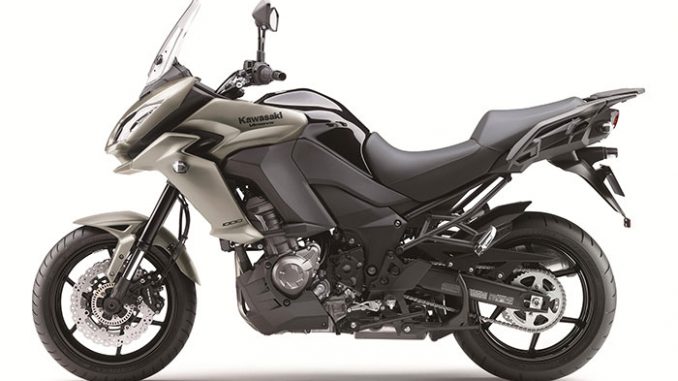
2016 Kawasaki Versys 1000
2016 Kawasaki Versys 1000 Review
2016 Kawasaki Versys 1000 on www.Totalmotorcycle.com
Change Your View…
On any-street, the new Versys 1000 offers maximum riding enjoyment. Solo or two-up, around the corner or around the globe, a unique combination of a highly responsive In-Line Four engine plus a nimble chassis is a recipe for riding fun. Add in the upright riding position and you have a package that is an ideal city roamer that really comes into its own on twisty mountain roads.
Available in Versys 1000, Versys 1000 Tourer and Versys 1000 Grand Tourer versions.
2016 Kawasaki Versys 1000 www.Totalmotorcycle.com Key Features
Sharp, sporty styling
Completely revised styling package blends style, wind protection, aerodynamics and airflow management. The new twin headlamp design contributes to strong Kawasaki looks, while reflecting the Versys 1000’s abundant potential for fun, sporty riding.
2016 Kawasaki Versys 1000 www.Totalmotorcycle.com Features and Benefits
Thickly padded seat
Deep cushioning and tailor-designed seat material offer superb comfort for long-distance riding
Centre stand
Standard centre stand facilitates maintenance chores.
Triple Petal Disc Brakes with Latest-spec ABS
Larger front discs are complemented by new pad material designed to deliver stronger initial bite. ABS – standard on all models – offers additional reassurance when braking on low-grip or uneven surfaces.
Aluminium twin-tube frame
The frame’s light weight and high rigidity contribute to sharp, firm handling. New rubber upper engine mounts contribute to reduced vibration and greater handling and stability.
Lightweight and highly rigid, the frame uses the engine as a stressed member. It contributes to handling, offering a firm, planted feeling, good stability and light, nimble turning.
Upright riding position
Spacious, upright riding position enables easy machine control while contributing to rider comfort
Sporty 17” wheels
Lightweight 17” wheels front and back contribute to quick, sporty handling. New tyres contribute to enhanced road sports performance.
Assist & Slipper Clutch
Race-inspired clutch technology offers both a back-torque limiting function as well as a much lighter feel at the lever.
Assist & Slipper Clutch was developed based on feedback from racing activities. The clutch uses two types of cams (an assist cam and a slipper cam), offering two new functions not available on the standard clutch of the previous model.
Accessory 47L top case
An accessory top case (and mount) can be fitted. The top case is rated for 5 kg, and with its 47 litre volume is large enough to fit two fullface helmets (available as accessory).
Adjustable windscreen
Windscreen has a larger 75 mm range, adjustable without tools.
Clean-mount pannier system
Revised mounting system for the accessory panniers gives them a more integrated look, and ensures the rear of the bike looks sharp when the panniers are removed (Available as accessory).
ø43 mm inverted front fork
New inverted fork offers composed damping and excellent action in a variety of street riding situations. Reduced damping and revised top-out spring settings contribute to increased ride comfort.
Substantial payload
Robust trellis-style rear frame is the key to the Versys 1000’s substantial payload, enabling riders to mount accessory panniers, a top case, or both.
Numerous genuine accessories
Complementing the colour-matched panniers and largervolume top case, numerous other accessories increase touring ability and contribute to long-distance comfort.
Newly available accessories include a helmet lock, LED fog lamps and a gear position indicator.
Stiffer rear shock spring
Stiffer rear shock spring (109 N/m) offers increased stability and more composed movement. The stiffer spring also suits the Versys 1000’s increased curb mass.
A remote preload adjuster means changes to suit tandem riding or luggage can be made quickly and easily by hand. The rear shock is also adjustable for rebound damping.
1,043 cm3 liquid-cooled, 4-stroke In-line Four
To maximise the Versys 1000’s fun factor, engineers wanted to provide the most exciting engine possible. The engine needed to deliver more than just performance figures. The engine they chose was a 1,043 cm3 In-line Four, tuned for flexibility. Superb throttle response, strong torque at all rpm (especially in the low-mid range), and a seductive intake howl ensure that every twist of the throttle delivers a physical and aural sensation that riders may easily find addictive.
Large-volume fuel tank
With engine and transmission settings, range (calculated)
on one tank could be 400 km.21 litre capacity enables long range between fill-ups (Range would vary depending on riding speed and conditions).
Wide handlebar
Wide handlebar offers easy control, especially for low-speed manoeuvring. Positioned to offer a natural grip, it allows the rider’s elbows to be slightly bent when sitting in a relaxed, upright stance.
Instrumentation
Tough-design multi-function instrumentation includes an analogue style tachometer and LCD with speedometer, fuel gauge, odometer, clock, dual trip meters, current and average fuel consumption, remaining range, and external air temperature. Large analogue-style tachometer is complemented by a multi-function LCD screen controlled by a convenient handle switch. Revised meter face adds to sporty looks.
ABS
Sudden over-application of the brakes, or braking on low-grip surfaces (surfaces with a low coefficient of friction) such as wet asphalt or manhole covers may cause a motorcycle’s wheel(s) to lock up and slip. ABS was developed to prevent such incidents. Kawasaki ABS systems are controlled by high precision and highly reliable programming formulated based on thorough testing of numerous riding situations. By ensuring stable braking performance, they offer rider reassurance that contributes to greater riding enjoyment.
And to meet the special requirements of certain riders, specialised ABS systems are also available. For example, KIBS (Kawasaki Intelligent anti-lock Brake System) is a high-precision brake system designed specifically for supersport models, enabling sport riding to be enjoyed by a wider range of riders. And by linking the front and rear brakes, K-ACT (Kawasaki Advanced Coactive-braking Technology) ABS provides the confidence to enjoy touring on heavyweight models. Kawasaki is continually working on the development of other advanced ABS systems.
Horizontal Back-link Rear Suspension
Compared to Kawasaki’s traditional Uni-Trak rear suspension, which mounts the shock unit vertically, with Horizontal Back-link rear suspension, the shock unit is almost horizontal. Kawasaki’s original suspension arrangement locates the shock unit very close to the bike’s centre of gravity, greatly contributing to mass centralisation.
And because there is no linkage or shock unit protruding beneath the swingarm, this frees up space for a larger exhaust pre-chamber (an exhaust expansion chamber situated just upstream of the silencer). With a larger pre-chamber, silencer volume can be reduced, and heavy exhaust components can be concentrated closer to the centre of the bike, further contributing to mass centralisation. The result is greatly improved handling.
Another benefit is that the shock unit is placed far away from exhaust heat. Because it is more difficult for heat from the exhaust system to adversely affect suspension oil and gas pressure, suspension performance is more stable. Horizontal Back-link rear suspension offers numerous secondary benefits like this.
Assist & Slipper Clutch
Based on feedback from racing activities, the Assist & Slipper Clutch uses two types of cams (an assist cam and a slipper cam) to either drive the clutch hub and operating plate together or apart.
Under normal operation, the assist cam functions as a self-servo mechanism, pulling the clutch hub and operating plate together to compress the clutch plates. This allows the total clutch spring load to be reduced, resulting in a lighter clutch lever feel when operating the clutch.
When excessive engine braking occurs – as a result of quick downshifts (or an accidental downshift) – the slipper cam comes into play, forcing the clutch hub and operating plate apart. This relieves pressure on the clutch plates to reduce back-torque and help prevent the rear tyre from hopping and skidding.
KTRC (3-mode)
KTRC (3-mode)
3-mode KTRC combines the traction control technology of both 1-mode KTRC, which provides enhanced stability in slippery situations by preventing wheel slip, and S-KTRC, which helps maintain optimum traction in sport riding situations by predicting the rear wheel slip ratio during acceleration, into a single system.
The convenient handle switch allows the type of traction control to be changed instantly by selecting one of the three modes, even while riding. Modes 1 and 2 maintain optimum traction during cornering, like S-KTRC. Designed with sport riding in mind, they enable sharp acceleration out of corners by maximising forward drive from the rear wheel. Modes 1 and 2 differ in the amount that they intervene. Mode 1, set for dry, good-grip road conditions, maintains the ideal slip ratio to ensure optimum traction.
Mode 3 operates like 1-mode KTRC, reducing power to allow grip to be regained when rear wheel spin is detected. It is ideal when riding in slippery conditions or in the wet. Enabling riders to easily change traction control character, 3-mode KTRC is Kawasaki’s most advanced engine management system.
Power Modes
Power modes offer riders an easily selectable choice between Full and Low Power. While Full Power is unrestricted, in Low Power mode maximum power is limited to approximately 75-80% of Full. Response is also milder in Low Power mode. Riders may opt to use Low Power mode for rainy conditions or city riding, and Full Power when sport riding.
Available on the Ninja ZX-14R / ZZR1400, Versys 1000 and other key models, when combined with the 3-mode KTRC (+ OFF) traction control system, Power Mode selection offers a total of eight combinations (KTRC: Mode 1/2/3+OFF x Power Mode: Full/Low) to suit a wide range of riding situations. For example, an experienced rider enjoying sport riding on dry pavement might choose Full Power and Mode 1. On a wet or slippery surface, choosing Low Power and Mode 3 would yield the lowest chance of incurring wheel spin, and with the milder throttle response would offer a high level of riding safety.
Dual Throttle Valves
Late-model sport bikes often use large-bore throttle bodies to generate high levels of power. However, with large diameter throttles, when a rider suddenly opens the throttle, the unrestricted torque response is anything but gentle and often more than the rider can handle. Dual throttle valve technology was designed to tame engine response while contributing to performance.
On fuel-injected models, throttle bodies generally have only one throttle valve per cylinder. On models with dual throttle valves, there are two throttle valves per cylinder: in addition to the main valves, which are physically linked to the throttle grip and controlled by the rider, a second set of valves, opened and closed by the ECU, precisely regulates intake airflow to ensure a natural, linear response. With the air passing through the throttle bodies becoming smoother, combustion efficiency in improved and power is increased.
Like other Kawasaki engine management technology, Dual Throttle Valves were designed with the philosophy of “following the rider’s intention, while providing natural-feeling support.” They are featured on many Kawasaki models.
Economical Riding Indicator
Using high-precision electronic control for engine management, Kawasaki models can achieve a high level of fuel efficiency.
However, fuel consumption is greatly affected by throttle use, gear selection, and other elements under the rider’s control. The Economical Riding Indicator is a function that indicates when current riding conditions are consuming a low amount of fuel. The system continuously monitors fuel consumption, regardless of vehicle speed, engine speed, throttle position and other riding conditions. When fuel consumption is low for a given speed (i.e. fuel efficiency is high), an “ECO” mark appears on the instrument panel’s LCD screen. By riding so that the “ECO” mark remains on, fuel consumption can be reduced.
While effective vehicle speed and engine speed may vary by model, paying attention to conditions that cause the “ECO” mark to appear can help riders improve their fuel efficiency – a handy way to increase cruising range. Further, keeping fuel consumption low also helps minimise negative impact on the environment.
2016 Kawasaki Versys 1000 – www.Totalmotorcycle.com USA Specifications/Technical Details
US MSRP Price: $NA USD
NA
2016 Kawasaki Versys 1000 – www.Totalmotorcycle.com Canadian Specifications/Technical Details
Canada MSRP Price: $ See Dealer for pricing in CDN
NA
2016 Kawasaki Versys 1000 – www.Totalmotorcycle.com European Specifications/Technical Details
Europe/UK MSRP Price: £9,949 GBP (On The Road inc 20% Vat)
Engine
Engine type
Liquid-cooled, 4-stroke In-Line Four
Displacement
1,043 cm3
Bore x stroke
77.0 x 56.0 mm
Compression ratio
10.3:1
Valve/Induction system
DOHC, 16 valves
Fuel system
Fuel injection: ø38 mm x 4 with oval sub-throttles
Ignition
Digital
Starting
Electric
Lubrication
Forced lubrication, wet sump
Frame
Frame type
Twin-tube, aluminium
Rake/Trail
27?/106 mm
Wheel travel, front
150 mm
Wheel travel, rear
150 mm
Tyre, front
120/70ZR17M/C (58W)
Tyre, rear
180/55ZR17M/C (73W)
Steering angle, left / right
34?/34?
Performance
Maximum power
88.2 kW {120 PS} / 9,000 min
Maximum torque
102.0 N.m {10.4 kgf.m} / 7,500 min
Transmission
Transmission
6-speed, return
Final Drive
Chain
Primary reduction ratio
1.627 (83/51)
Gear ratios: 1st
2.692 (35/13)
Gear ratios: 2nd
1.950 (39/20)
Gear ratios: 3rd
1.529 (26/17)
Gear ratios: 4th
1.304 (30/23)
Gear ratios: 5th
1.136 (25/22)
Gear ratios: 6th
0.958 (23/24)
Final reduction ratio
2.867 (43/15)
Clutch
Wet multi-disc, manual
Brakes
Brakes, front
Dual semi-floating ø310 mm petal discs; Caliper: Dual opposed 4-piston
Brakes, rear
Single ø250 mm petal disc; Caliper: Single-piston
Suspension
Suspension, front
ø43 mm inverted fork with rebound damping (right-side) and spring preload adjustability
Suspension, rear
Horizontal Back-link, gas-charged, with rebound damping and remote spring preload adjustability
Dimensions
Dimensions (L x W x H)
2,240 x 895 x 1,400/1,465 (high position) mm
Wheelbase
1,520 mm
Ground Clearance
150 mm
Fuel capacity
21 litres
Seat height
840 mm
Curb Mass
250 kg
*Starting at MSRP is the manufactured suggested price and excludes delivery, setup, tax, title, license, and additional fees and expenses. Bikes may be shown with optional accessories. Final sale price determined by an authorized dealer. Specifications and MSRP are subject to change.
Manufacturer Specifications and appearance are subject to change without prior notice on Total Motorcycle (TMW).


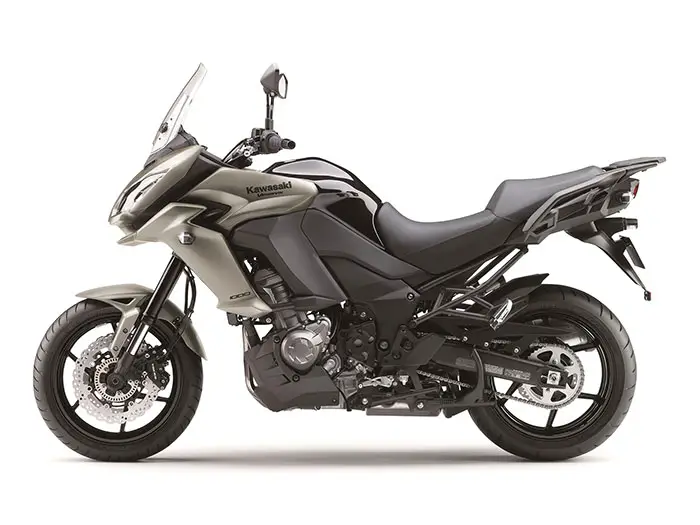
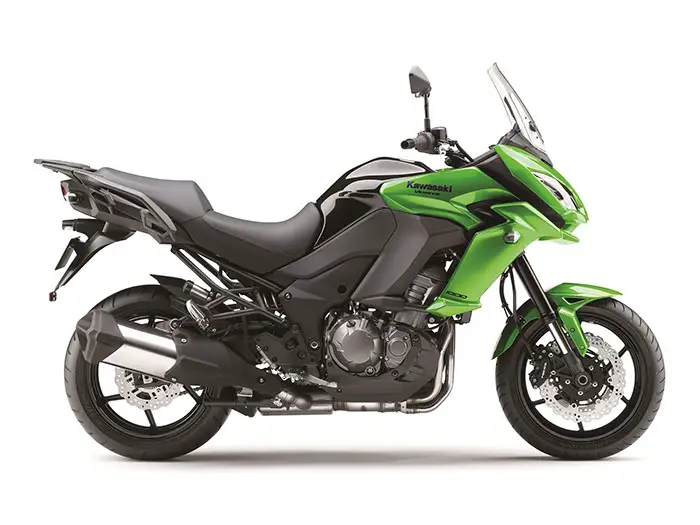
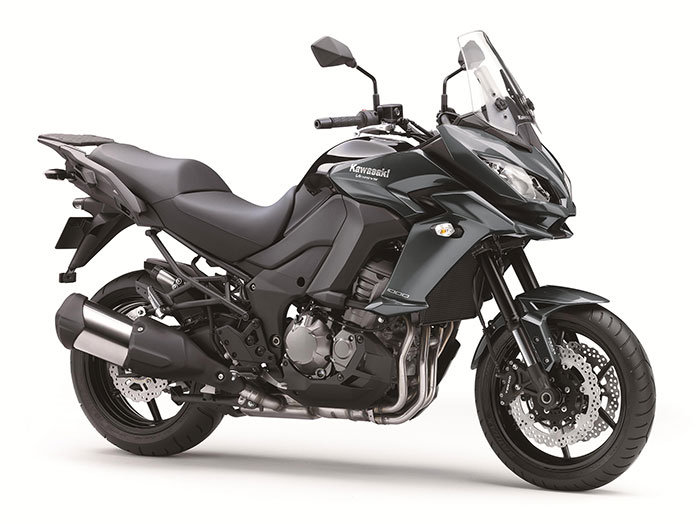
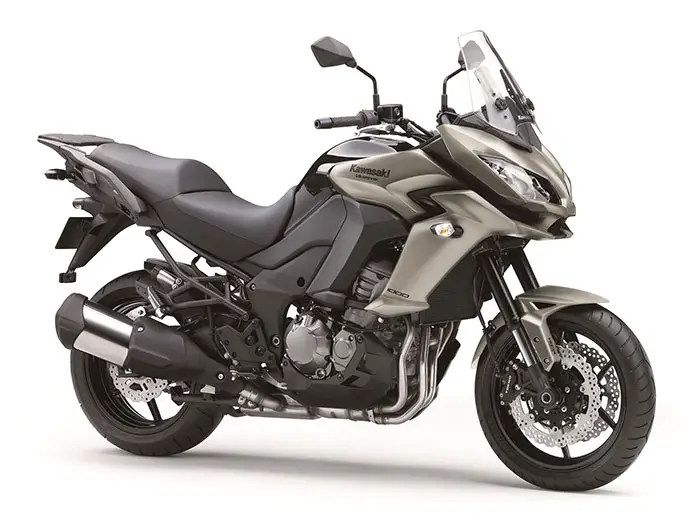

Be the first to comment